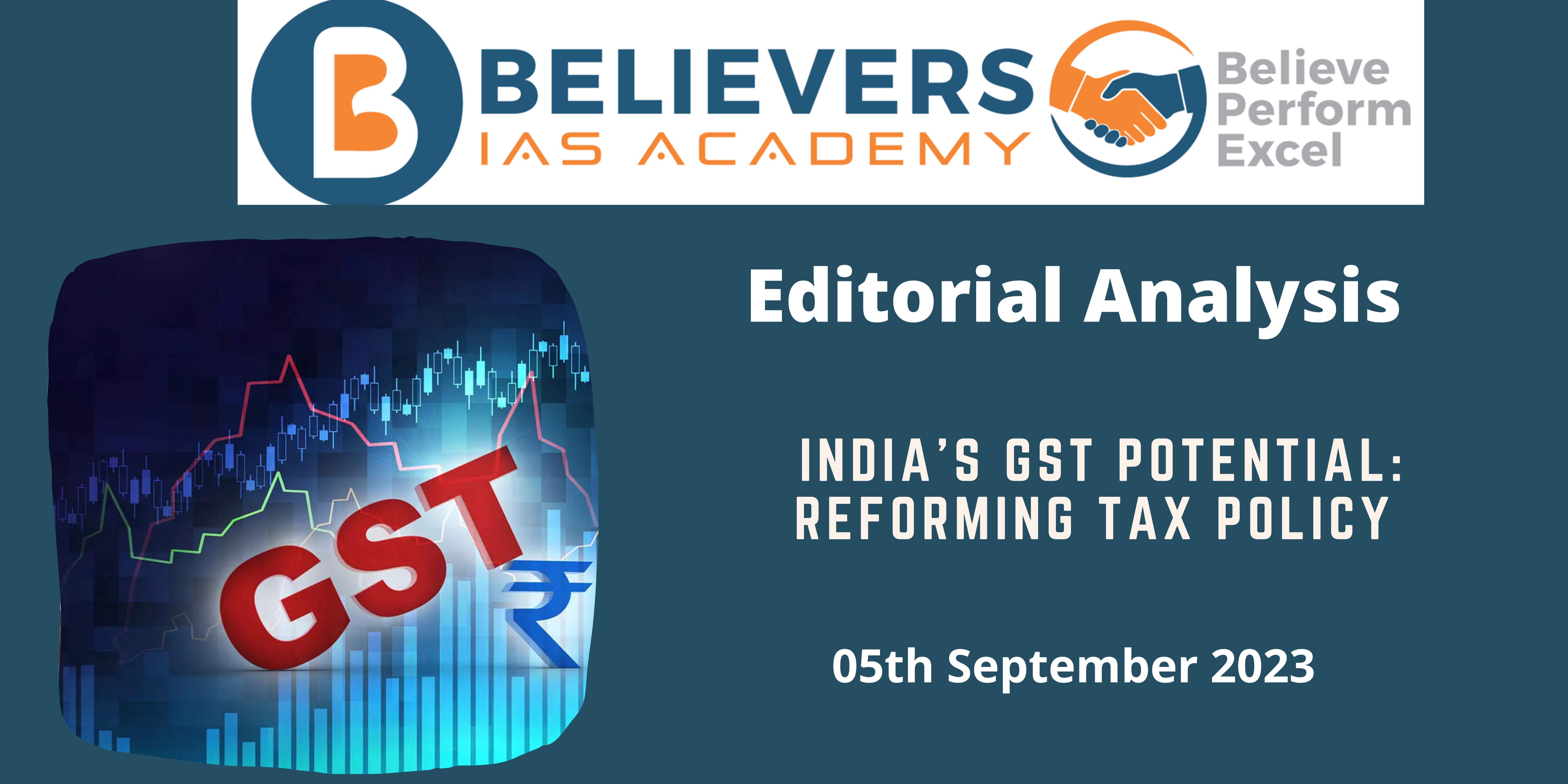India’s GST Potential: Reforming Tax Policy
Context:
India’s Goods and Services Tax (GST) collections have shown promising figures in the first five months of 2023-24 which provides room for consideration of revising tax rates, simplifying the complex GST structure, and addressing inflation.
Relevance:
GS-02, GS-03 (Government Policies and Interventions, Growth and Development, Indian Economy)
Prelims:
- GST council
- Inflation
- One nation one tax
Mains Question:
- Discuss the significance of the Goods and Services Tax (GST) in transforming India’s tax landscape. Analyze the challenges faced during its implementation and the measures taken to ensure compliance. (250 words)
Dimensions of the Article:
- Steady Growth in GST Revenues
- Mixed Signals in Revenue Sources
- Effect of Mandatory E-Invoicing
- Simplifying the Complex GST Structure
- Balancing Political and Economic Priorities
- Way Forward
Steady Growth in GST Revenues:
- GST revenues of the initial five months of the FY 2023-24 have hit 11.3% growth which has a monthly average of ₹1.66 lakh crore, showing an increase from around ₹1.5 lakh crore in the previous year.
- The first quarter of the fiscal year showed a slightly higher growth rate 11.5% as compared to July and August where it was a slow rise since July 2021.
- August: Revenues related to July transactions reached a 3month low of ₹1.59 lakh crore, down from July’s 3month high of ₹1.65 lakh crore.
Mixed Signals in Revenue Sources:
- When we break down the numbers, we observe that revenues from goods imports saw a 3% rise in August after experiencing two months of contraction. This hints at a potential recovery in discretionary demand.
- Revenues from domestic transactions and services imports grew by 13.8%, which is slower than the 15.1% growth witnessed in July. The upcoming festive season may contribute to revenue growth from both sources.
- Yet, the resurgence of high inflation might shift momentum towards items preferred by high-income households, leaving those with lower incomes struggling to cope with rising food prices, potentially reducing spending on other goods.
Effect of Mandatory E-Invoicing:
- The mandatory implementation of e-invoicing for firms with an annual turnover exceeding ₹5 crore is expected to positively impact this month’s revenues. However, the true effect of this change will likely become evident in the next couple of months.
- Despite this, the overall trajectory of GST revenues remains promising, supported by efforts to combat evasion and fake registrations. These trends alleviate concerns about lackluster collections during the initial years of GST implementation.
Simplifying the Complex GST Structure:
- The robust GST revenue presents an opportunity to simplify and rationalize the multiple-rate GST structure, a concept introduced by the GST Council in 2021.
- The Finance Ministry had previously indicated that this restructuring would have to wait until inflation subsides. However, this year, it suggested that the rationalization plan is on hold, even before the recent surge in prices.
- A ministerial group (GoM) responsible for recommending a new rate structure has yet to be reconstituted.
Balancing Political and Economic Priorities:
- While political considerations might limit the scope for a major GST overhaul, postponing this move could hinder economic growth potential.
- Skillfully implemented changes in tax rates could also aid in the battle against inflation, especially for essential items.
- Given the complexity of this exercise, it is crucial to continue the dialogue with States by reviving the GoM rather than starting anew a year later.
Way Forward:
- The encouraging growth in GST revenues provides a moment to revisit India’s tax policy. A balanced approach that addresses both economic and political concerns should guide any restructuring efforts.
- The complexity of the GST system necessitates collaboration and ongoing dialogue with State governments to ensure a smooth transition towards a more simplified and effective tax regime.
Conclusion:
While the recent slowdown in GST revenue growth may raise concerns, the overall graph is promising. This growth creates an opening for tax policy reform, specifically simplifying the GST structure, which has the potential to stimulate economic growth and manage inflation. Balancing political considerations with economic imperatives will be crucial in shaping the future of India’s tax system and ensuring the well-being of its citizens.




